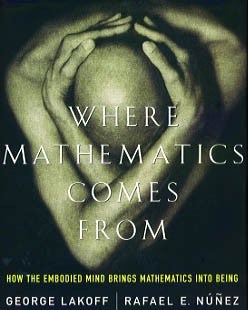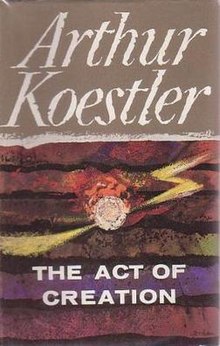
A concept is defined as an abstract idea. It is understood to be a fundamental building block underlying principles, thoughts, and beliefs. Concepts play an important role in all aspects of cognition. As such, concepts are studied within such disciplines as linguistics, psychology, and philosophy, and these disciplines are interested in the logical and psychological structure of concepts, and how they are put together to form thoughts and sentences. The study of concepts has served as an important flagship of an emerging interdisciplinary approach, cognitive science.

A metaphor is a figure of speech that, for rhetorical effect, directly refers to one thing by mentioning another. It may provide clarity or identify hidden similarities between two different ideas. Metaphors are usually meant to create a likeness or an analogy.

Where Mathematics Comes From: How the Embodied Mind Brings Mathematics into Being is a book by George Lakoff, a cognitive linguist, and Rafael E. Núñez, a psychologist. Published in 2000, WMCF seeks to found a cognitive science of mathematics, a theory of embodied mathematics based on conceptual metaphor.

George Philip Lakoff is an American cognitive linguist and philosopher, best known for his thesis that people's lives are significantly influenced by the conceptual metaphors they use to explain complex phenomena.
In cognitive linguistics, conceptual metaphor, or cognitive metaphor, refers to the understanding of one idea, or conceptual domain, in terms of another. An example of this is the understanding of quantity in terms of directionality or the understanding of time in terms of money.

Analogy is a comparison or correspondence between two things because of a third element that they are considered to share.

Creativity is a characteristic of someone that forms something novel and valuable. The created item may be intangible or a physical object. Creativity enables people to solve problems in new or innovative ways.
A holon is something that is simultaneously a whole in and of itself, as well as a part of a larger whole. In this way, a holon can be considered a subsystem within a larger hierarchical system.
In cognitive linguistics, conceptual blending, also called conceptual integration or view application, is a theory of cognition developed by Gilles Fauconnier and Mark Turner. According to this theory, elements and vital relations from diverse scenarios are "blended" in a subconscious process, which is assumed to be ubiquitous to everyday thought and language. Much like memetics, it is an attempt to create a unitary account of the cultural transmission of ideas.
In music, especially folk and popular music, a matrix is an element of variations which does not change. The term was derived from use in musical writings and from Arthur Koestler's The Act of Creation, who defines creativity as the bisociation of two sets of ideas or matrices. Musical matrices may be combined in any number, usually more than two, and may be — and must be for analysis — broken down into smaller ones. They are not necessarily intended by the composer or perceived by the listener, and they may be purposefully ambiguous.
Creativity techniques are methods that encourage creative actions, whether in the arts or sciences. They focus on a variety of aspects of creativity, including techniques for idea generation and divergent thinking, methods of re-framing problems, changes in the affective environment and so on. They can be used as part of problem solving, artistic expression, or therapy.
Synectics is a problem solving methodology that stimulates thought processes of which the subject may be unaware. This method was developed by George M. Prince (1918–2009) and William J.J. Gordon, originating in the Arthur D. Little Invention Design Unit in the 1950s.
Dedre Dariel Gentner is an American cognitive and developmental psychologist. She is the Alice Gabriel Twight Professor of Psychology at Northwestern University, and a leading researcher in the study of analogical reasoning.

Mark Turner is a cognitive scientist, linguist, and author. He is Institute Professor and Professor of Cognitive Science at Case Western Reserve University. He has won an Anneliese Maier Research Prize from the Alexander von Humboldt Foundation (2015) and a Grand Prix from the French Academy (1996) for his work in these fields. Turner and Gilles Fauconnier founded the theory of conceptual blending, presented in textbooks and encyclopedias. Turner is also the director of the Cognitive Science Network (CSN) and co-director of the Distributed Little Red Hen Lab.

Analogical models are a method of representing a phenomenon of the world, often called the "target system" by another, more understandable or analysable system. They are also called dynamical analogies.

The following outline is provided as an overview of and topical guide to thought (thinking):

Metaphors We Live By is a book by George Lakoff and Mark Johnson published in 1980. The book suggests metaphor is a tool that enables people to use what they know about their direct physical and social experiences to understand more abstract things like work, time, mental activity and feelings.

Todd Siler is an American multimedia artist, author, educator, and inventor, equally well known for his art and for his work in creativity research. A graduate of Bowdoin College, he became the first visual artist to be granted a PhD from MIT. Siler began advocating the full integration of the arts and sciences in the 1970s and is the founder of the ArtScience Program and movement.

Computational creativity is a multidisciplinary endeavour that is located at the intersection of the fields of artificial intelligence, cognitive psychology, philosophy, and the arts.
Although humor is a phenomenon experienced by most humans, its exact cause is a topic of heavy debate. There are many theories of humor which attempt to explain what it is, what social functions it serves, and what would be considered humorous. Although various classical theories of humor and laughter may be found, in contemporary academic literature, three theories of humor appear repeatedly: relief theory, superiority theory, and incongruity theory. These theories are used as building blocks for the rest of the theories. Among current humor researchers, there has yet to be a consensus about which of these three theories of humor is most viable. Proponents of each theory originally claimed that theirs explained all cases of humor, and that it was the only one capable of doing so. However, they now acknowledge that although each theory generally covers its area of focus, many instances of humor can be explained by more than one theory. Similarly, one view holds that theories have a combinative effect; Jeroen Vandaele claims that incongruity and superiority theories describe complementary mechanisms that together create humor.












